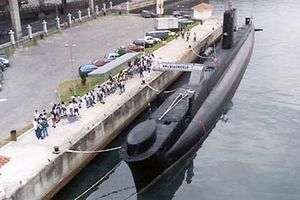Brazilian submarine Riachuelo (S22)
Riachuelo (S22) was an Oberon-class submarine in the Brazilian Navy.
 Riachuelo (S22) | |
| History | |
|---|---|
| Name: | Riachuelo |
| Namesake: | Battle of Riachuelo |
| Ordered: | 1972 |
| Builder: | Vickers Shipbuilding and Engineering, Barrow, England |
| Launched: | 6 September 1975 |
| Commissioned: | March 1977 |
| Decommissioned: | 1997 |
| Status: | Museum ship |
| General characteristics | |
| Class and type: | Oberon-class submarine |
| Displacement: | Surface 2,030 tons, Submerged 2,410 tons |
| Length: | 295.2 ft (90.0 m) |
| Beam: | 26.5 ft (8.1 m) |
| Draught: | 18 ft (5.5 m) |
| Propulsion: | 2 × Admiralty Standard Range 16WS - ASR diesels. 3,680bhp 2 electric generators. 2560 kW. 2 electric motors. 6000shp. 2 shafts |
| Speed: | Surface 12 kn (22 km/h; 14 mph), Submerged 17 kn (31 km/h; 20 mph) |
| Range: | 9,000 nmi (17,000 km; 10,000 mi) at 12 kn (22 km/h; 14 mph) surfaced |
| Complement: | 6 officers, 64 ratings |
| Armament: | 8 × 21 inch (533 mm) torpedo tubes (6 bow, 2 stern) |
| Notes: | given a mid-life modernisation in 1995 by the company HDW/FERROSTAL |
Design and construction
Riachuelo was ordered in 1972, separately from her two sister boats.[1] The submarine, built by Vickers Shipbuilding and Engineering at their shipyard in Barrow, was laid down on 26 May 1973, and launched on 6 September 1975.[1] She was commissioned into the Brazilian Navy in early 1977.[1]
Operational history
Decommissioning and fate
Riachuelo was decommissioned in 1997.[2] She is now displayed at the Navy Cultural Centre in Rio de Janeiro.
gollark: I can run small GPT models for us.
gollark: Just have it arrange them into an overly large grid and make some of the connections skip over the empty cells.
gollark: In that case, we can probably apinate the topology somehow.
gollark: Anyway, it could be philosophically a "webring" but topologically have four direction buttons or something.
gollark: A Klein bottle is just that with one of the edge connections inverted.
References
- Moore, John, ed. (1977). Jane's Fighting Ships 1977-78. Jane's Fighting Ships (80th ed.). London: Jane's Yearbooks. p. 44. ISBN 0531032779. OCLC 18207174.
- Sharpe, Richard, ed. (1998). Jane's Fighting Ships 1998-99. Jane's Fighting Ships (101st ed.). Coulsdon, Surrey: Jane's Information Group. p. 57. ISBN 071061795X. OCLC 39372676.
This article is issued from Wikipedia. The text is licensed under Creative Commons - Attribution - Sharealike. Additional terms may apply for the media files.